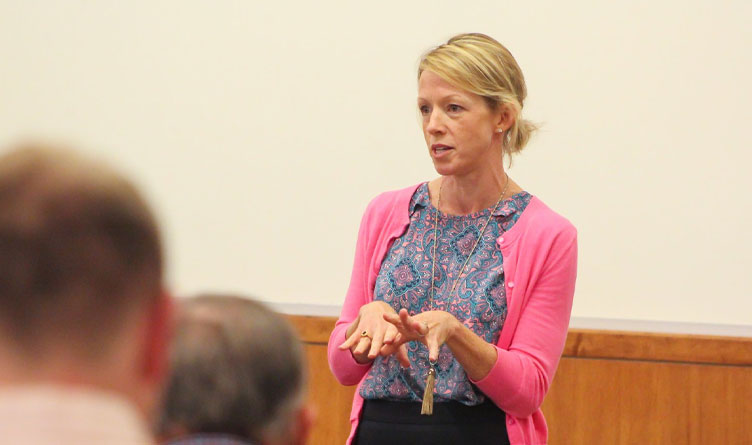Photo Credit: Haslam College of Business – UT / Facebook
The Center Square [By Jon Styf] –
For Tennessee’s labor force to continue to grow, it will need to depend on in-migration from the rest of the country, according to Marianne Wanamaker, executive director of the University of Tennessee’s Howard Baker Center for Public Policy.
Wanamaker told the Tennessee Senate Commerce and Labor Committee last week that deaths in Tennessee exceeded births by 7% in 2020. That was part of a trend where the number of deaths and births in the state were getting close to the same number each year, something Wanamaker said was on pace to happen by 2024 even without the COVID-19 pandemic.
“There is no reasonable amount of productivity growth or automation that can help an economy grow if the population is shrinking at such a rapid rate,” Wanamaker said. “Attracting workers from other states is no longer just an important part of our labor force strategy. It really is the entire story over the medium term.”
Wanamaker served as chief domestic economist and senior labor economist at the White House Council of Economic Advisors during the Trump administration. She said trends already showed labor would be difficult in 2021 and 2022, but COVID-19 led to more retirement-age female workers leaving the workforce forever.
She said production, however, has surpassed pre-pandemic levels in Tennessee and across the U.S. because of a “substantial shift in hours worked.”
While the number of part-time workers in Tennessee is down 8% since the start of the pandemic, Wanamaker said, the number of full-time workers is down only 1%. The labor force in the country is up 3% since 2015, and Tennessee and Texas are up more than 9%, Wanamaker said. Illinois shrunk 4% over that time.
“From an output perspective, the economy is operating as though COVID never happened,” Wanamaker said. “This is true in the state of Tennessee where GDP in the third quarter of 2021 was 3% larger than in the fourth quarter of 2019. The U.S. economy was 1.4% larger in the third quarter of 2021 than at the end of 2019.”
Wanamaker said there is eight-tenths of an unemployed person for each job opening nationally. There is one unemployed person per opening in the west, but in Tennessee, there is one-half of an unemployed person per job opening, which Wanamaker said was one of the lowest rates in the country.
Wanamaker believes it is unlikely the 2.1 million workers in Tennessee who left jobs during the pandemic will return.
“I believe population and labor-force dynamics are the major policy challenge of the next five to 10 years,” Wanamaker said. “Supply chain snarls will abate, states like ours will build the infrastructure we need to support our transportation future and it remains very possible that the [Federal Reserve] will find a soft landing on inflation that will keep us out of a double-dip recession.
“Meanwhile, the labor shortage and the lack of population growth is going to be a challenge with 100% certainty.”
*** Click Here to Support Conservative Journalism in Tennessee. We can’t bring your articles like this without your support!***
When asked, Wanamaker said it is clear several factors have led to people leaving the workforce entirely, including an influx of income from a 30% increase in the stock market and rising home values. She said it is clear the income allowing people to leave the workforce is not only unemployment payments, which have lowered considerably since their peak rates during the pandemic.
“I was reading the other day that as us war babies and baby boomers are dying off, there’s been a huge transfer of wealth to the snowflake millennials,” Sen. Frank Niceley, R-Strawberry Plains, told Wanamaker before asking what impact it is having. “One of the biggest transfers of wealth in history. And, a lot of ’em don’t have to work now.”
Wanamaker said the rates of residents remaining out of the workforce are consistent across education levels, from those with master’s degrees to those with high school diplomas.
“They are all exhibiting the same patterns,” Wanamaker said.

About the Author: Jon Styf, The Center Square Staff Reporter – Jon Styf is an award-winning editor and reporter who has worked in Illinois, Texas, Wisconsin, Florida and Michigan in local newsrooms over the past 20 years, working for Shaw Media, Hearst and several other companies. Follow Jon on Twitter @JonStyf.






One Response
I recently applied for a Truck driving job and was told because I had not been employed as a Driver in the last ten years, I was ineligible for employment.
Most cited their insurance companies as being the reason.
I have over 25 years experience driving a truck, Coast to Coast, Border to Border, Pulling Mobile Homes, Vans, Flatbeds and Fuel Tankers.
Is it any wonder America is short about 80,000 drivers when a person right out of driver’s school who has never earned their first pay check as a driver can be hired but drivers with my experience can’t be hired???
The 467,000 jobs added last month is proof this economy is heating up but the lack of Truck Drivers is going to be the choke point that prevents it from freely expanding.
As is evidence by the driver shortage, insufficient number of people are joining the trucking industry to keep up with demands,
And trucks are the blood that flows through the interstate system that keeps this country alive, without them or an insufficient number of them, America will die.
I’m sure there are other drivers like me who find themselves in the same situation.
But with backwards policies that prevents rather than promote the transportation industry,
and the lack of an infusion of drivers is going to doom America to a slow death.